
Image Source: http://www.simplum.com
Many people need to convert Metric Units as part of their job.
People such as Tradesmen, Engineers, Scientists, Construction Workers, Doctors, Pharmacists, Fashion Designers, Interior Decorators, Architects, Builders, Statisticians, Nurses, Firemen, CSI Detectives, and many others.
In this lesson we look at Converting Metric Units of Length, Area, Volume, Capacity, and Mass.
Converting Metric Length
Metric Lengths are in Kilometres (km), Meters (m), Centimetres (cm), and Millimetres (mm).
The following Conversion Chart can be used to convert metric units of Length.
![]()
Image Copyright 2013 by Passy’s World of Mathematics
Metric LENGTH Converter
The following web page has an easy to use online metric length converter.
http://www.onlineconversion.com/length_metric.htm
Converting Metric Area
Area units are simply the normal metric lengths squared.
A 1km by 1km square is 1000m x 1000m in size, this means that to convert Km to m AREA, we have to multiply by 1000 x 1000, or 1000 squared.
A 1m by 1m square is 100cm x 100cm in size, this means that to convert m to cm AREA, we have to multiply by 100 x 100, or 100 squared.
A 1cm by 1cm square is 10mm x 10mm in size, this means that to convert cm to mm AREA, we have to multiply by 10 x 10, or 10 squared.
This is shown on the following conversion diagram.

Image Copyright 2013 by Passy’s World of Mathematics
In the Metric System there are special additional Area units for specifying the size of Land.
This unit is called the “Hectare” and is about two and a half Acres in size.
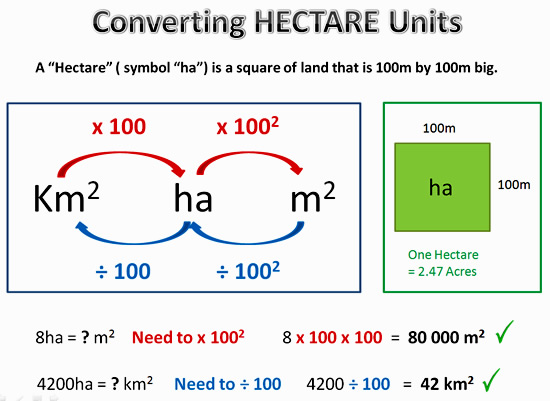
Image Copyright 2013 by Passy’s World of Mathematics
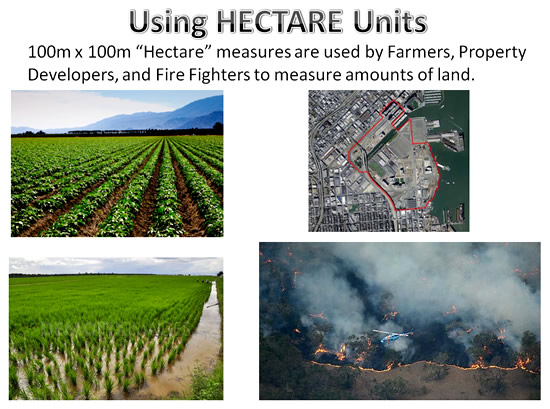
Image Copyright 2013 by Passy’s World of Mathematics
Metric AREA Converter
The following web page has an easy to use online metric AREA converter.
http://www.onlineconversion.com/area.htm
Converting Metric Volume
Volume units are simply the normal metric lengths cubed.
A 1km by 1km by 1km Cube is 1000m x 1000m x 1000m in size, this means that to convert Km to m VOLUME, we have to multiply by 1000 x 1000 x 1000, or 1000 Cubed which is 1000 to the power of three.
A 1m by 1m x 1m Cube is 100cm x 100cm x 100cm in size, this means that to convert m to cm VOLUME, we have to multiply by 100 x 100 x 100, or 100 Cubed which is 100 to the power of three.
A 1cm by 1cm x 1cm Cube is 10mm x 10mm x 10mm in size, this means that to convert cm to mm VOLUME, we have to multiply by 10 x 10 10, or 10 Cubed which is 10 to the power of three.
This is shown on the following conversion diagram.
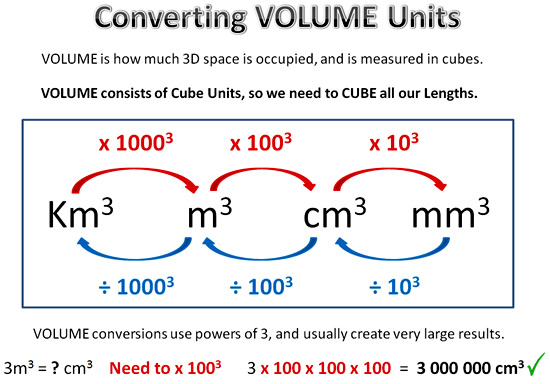
Image Copyright 2013 by Passy’s World of Mathematics
Volume Conversions often produce very big answers that are in the millions.
This happens simply because it can take a lot of cubes to fill up a 3D space.

Image Copyright 2013 by Passy’s World of Mathematics
Volume and Capacity
If we have a container filled with liquid or gas,the Volume is specified in “Capacity” units.
Capacity units are Millilitres (mL), Litres (L), Kilolitres (kL) and Megalitres (ML).
This means for Liquids and Gases in containers, we do not specify their volume in cubic centimetres or cubic meters.
The container they are in is a solid structure with Volume units of cubic centimetres or cubic meters, but the liquid or gas occupying the container has a Volume that is specified in Millilitres, or Litres.
Eg. Volume is how big the container is, but Capacity is how much the container can hold.
Container size is specified in cm or m cubed, but how much liquid or gas is in the container is specified in mL or L.

Image Copyright 2013 by Passy’s World of Mathematics
As a typical example of a “Capacity” type Volume, consider a standard 375ml can of Coca Cola.
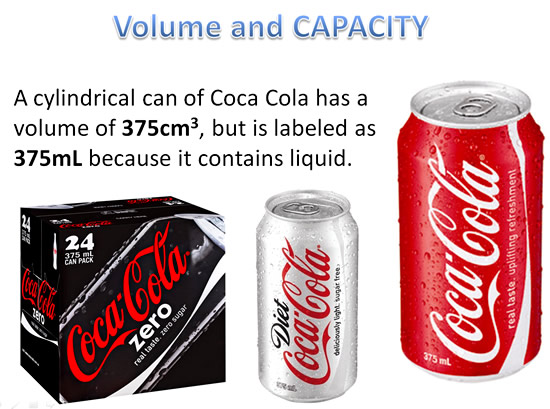
Image Copyright 2013 by Passy’s World of Mathematics
MegaLitres (ML) are a very large unit of Volume that is most commonly used to specify the Volume of Water contained in large Dams and Resevoirs.
One MegaLitre = 1 million Litres.
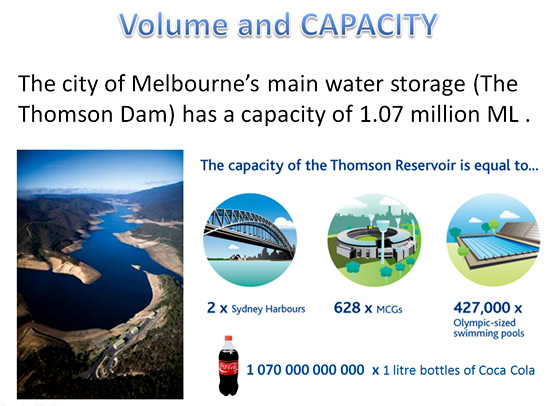
Image Copyright 2013 by Passy’s World of Mathematics
The following Conversion Diagram can be used for converting Capacity Units.
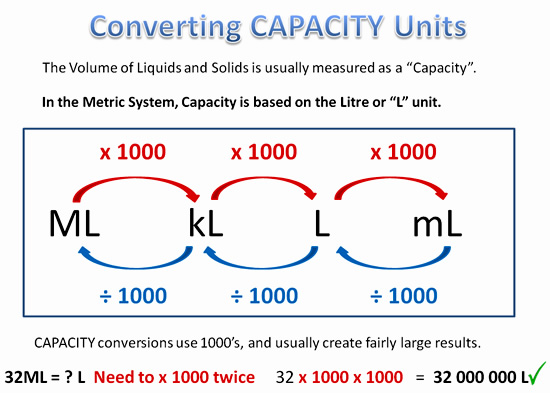
Image Copyright 2013 by Passy’s World of Mathematics
Metric VOLUME and Capacity Converter
The following web page has an easy to use online metric VOLUME and CAPACITY converter.
http://www.onlineconversion.com/volume.htm
Converting Metric Mass

Image Source: http://db2.stb.s-msn.com
When we measure the weight of objects in the Metric System, the units of mass we use are Tonnes, kilograms, grams, and milligrams.
A typical medium sized car weighs about a Tonne, which is the same as 1000 kilograms.
Medicine pills we take for illness often have many of their active ingredients present in very small amounts of milligrams.
(A milligram is one thousandth of a gram).
For converting Masses, the following chart can be used.
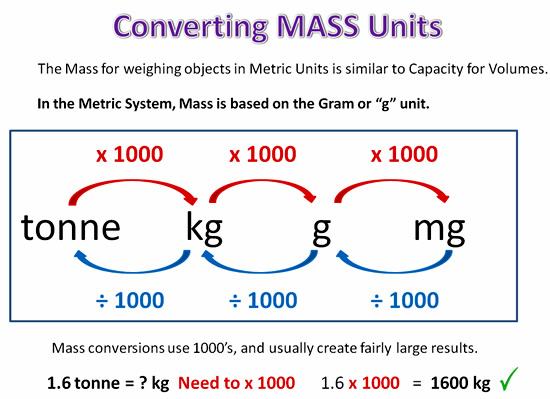
Image Copyright 2013 by Passy’s World of Mathematics
Metric Mass Converter
The following web page has an easy to use online metric MASS converter.
http://www.onlineconversion.com/weight_metric.htm
Ladder Method for Converting Metric Units
An alternative way of converting metric units is to use a method that involves shifting the decimal point.
The number of places that the decimal needs to be shifted depends on the number of “steps” that need to be taken along the ladder diagram to get from the original unit to the desired unit.
An example of using the “Ladder Method” is shown in the following diagram.

Image Source: http://i2.squidoocdn.com
Related Items
Free Online Calculators and Converters
Measurement Formulas
Subscribe
If you enjoyed this lesson, why not get a free subscription to our website.
You can then receive notifications of new pages directly to your email address.
Go to the subscribe area on the right hand sidebar, fill in your email address and then click the “Subscribe” button.
To find out exactly how free subscription works, click the following link:
If you would like to submit an idea for an article, or be a guest writer on our website, then please email us at the hotmail address shown in the right hand side bar of this page.
If you are a subscriber to Passy’s World of Mathematics, and would like to receive a free PowerPoint version of this lesson, that is 100% free to you as a Subscriber, then email us at the following address:
Please state in your email that you wish to obtain the free subscriber copy of the “Converting Metric Units” Powerpoint.
Like Us on Facebook
Our Facebook page has many additional items which are not posted to this website.
These include items of mathematical interest, funny math pictures and cartoons, as well as occassional glimpses into the personal life of “Passy”.
Check it out at the following link:
https://www.facebook.com/PassysWorldOfMathematics
While you are there, LIKE the page so you can receive our FB updates to your Facebook News Feed.
Help Passy’s World Grow
Each day Passy’s World provides hundreds of people with mathematics lessons free of charge.
Help us to maintain this free service and keep it growing.
Donate any amount from $2 upwards through PayPal by clicking the PayPal image below. Thank you!
PayPal does accept Credit Cards, but you will have to supply an email address and password so that PayPal can create a PayPal account for you to process the transaction through. There will be no processing fee charged to you by this action, as PayPal deducts a fee from your donation before it reaches Passy’s World.
Enjoy,
Passy


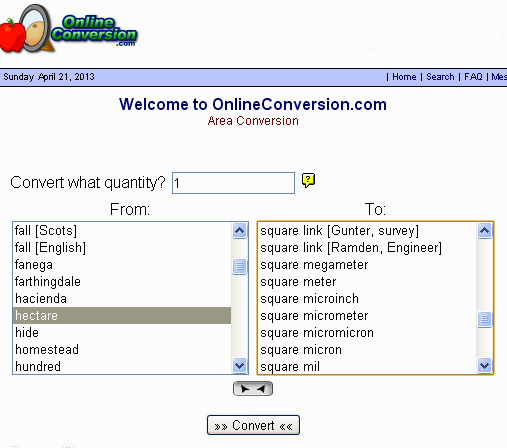
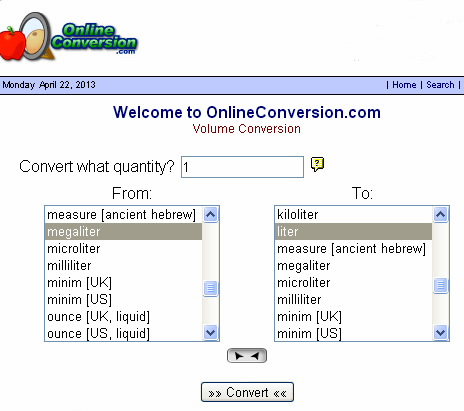
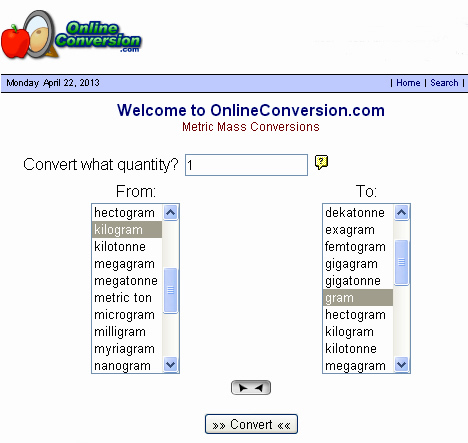




Pingback: Volume of Prisms | Passy's World of Mathematics